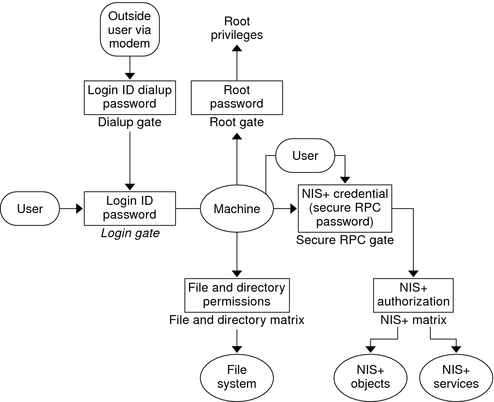| Skip Navigation Links | |
| Exit Print View | |

|
System Administration Guide: Naming and Directory Services (NIS+) |
| Skip Navigation Links | |
| Exit Print View | |

|
System Administration Guide: Naming and Directory Services (NIS+) |
Part I About Naming and Directory Services
Part II NIS+ Setup and Configuration
4. Configuring NIS+ With Scripts
5. Setting Up the NIS+ Root Domain
8. Configuring an NIS+ Non-Root Domain
10. NIS+ Tables and Information
NIS+ Security Levels and Password Commands
NIS+ Authentication and Credentials
NIS+ User and Machine Credentials
DES Credentials and LOCAL Credentials in NIS+
NIS+ User Types and Credential Types
Authorization Classes and the NIS+ Object Hierarchy
NIS+ Password, Credential, and Key Commands
12. Administering NIS+ Credentials
14. Administering Enhanced NIS+ Security Credentials
15. Administering NIS+ Access Rights
16. Administering NIS+ Passwords
18. Administering NIS+ Directories
20. NIS+ Server Use Customization
23. Information in NIS+ Tables
Common NIS+ Namespace Error Messages
In essence, Solaris security is provided by gates that users must pass through in order to enter the Solaris system, and permission matrixes that determine what they are able to do once inside. (See Figure 11-1 for a schematic representation of this system.)
Figure 11-1 Solaris Security Gates and Filters

As you can see in the above figure, the overall system is composed of four gates and two permission matrixes:
Dialup gate. To access a given Solaris system from the outside through a modem and phone line, you must provide a valid login ID and dialup password.
Login gate. To enter a given Solaris system you must provide a valid login ID and user password.
File and Directory Matrix. Once you have gained access to a Solaris system, your ability to read, execute, modify, create, and destroy files and directories is governed by the applicable permissions matrix.
Root gate. To gain access to root privileges, you must provide a valid super user (root) password.
Secure RPC gate. In an NIS+ environment running at security level 2 (the default), when you try to use NIS+ services and gain access to NIS+ objects (servers, directories, tables, table entries, and so forth) your identity is confirmed by NIS+ using the Secure RPC process.
Consult your Solaris documentation for detailed descriptions of the Dialup, Login, and Root gates, and the File and Directory permissions matrix.
To enter the Secure RPC gate requires presentation of a Secure RPC password. (In some contexts Secure RPC passwords have been referred to as network passwords.) Your Secure RPC password and your login password normally are identical and when that is the case you are passed through the gate automatically without having to re-enter your password. (See Secure RPC Passwords and the Login Password Problem in NIS+ for information regarding cases where the two passwords are not the same.)
A set of credentials are used to automatically pass your requests through the Secure RPC gate. The process of generating, presenting, and validating your credentials is called authentication because it confirms who you are and that you have a valid Secure RPC password. This authentication process is automatically performed every time you request an NIS+ service.
In an NIS+ environment running in NIS-compatibility mode (also known as YP-compatibility mode), the protection provided by the Secure RPC gate is significantly weakened because everyone has read rights for all NIS+ objects and modify rights for those entries that apply to them regardless of whether or not they have a valid credential (that is, regardless of whether or not the authentication process has confirmed their identity and validated their Secure RPC password). Since that allows anyone to have read rights for all NIS+ objects and modify rights for those entries that apply to them, an NIS+ network running in compatibility mode is less secure than one running in normal mode.
For details on how to create and administer NIS+ authentication and credentials, see Chapter 12, Administering NIS+ Credentials.
NIS+ objects matrix. Once you have been properly authenticated to NIS+ your ability to read, modify, create, and destroy NIS+ objects is governed by the applicable permissions matrix. This process is called NIS+ authorization.
For details NIS+ permissions and authorization, see Chapter 15, Administering NIS+ Access Rights.